
Francisco José de Goya y Lucientes was a Spanish romantic painter and printmaker. He is considered the most important Spanish artist of the late 18th and early 19th centuries. His paintings, drawings, and engravings reflected contemporary historical upheavals and influenced important 19th- and 20th-century painters. Goya is often referred to as the last of the Old Masters and the first of the moderns.

Diego Rodríguez de Silva y Velázquez was a Spanish painter, the leading artist in the court of King Philip IV of Spain and Portugal, and of the Spanish Golden Age. He is generally considered one of the greatest artists in the history of Western art.

Frederic Edwin Church was an American landscape painter born in Hartford, Connecticut. He was a central figure in the Hudson River School of American landscape painters, best known for painting large landscapes, often depicting mountains, waterfalls, and sunsets. Church's paintings put an emphasis on realistic detail, dramatic light, and panoramic views. He debuted some of his major works in single-painting exhibitions to a paying and often enthralled audience in New York City. In his prime, he was one of the most famous painters in the United States.

Emily Carr was a Canadian artist who was inspired by the monumental art and villages of the First Nations and the landscapes of British Columbia. She also was a vivid writer and chronicler of life in her surroundings, praised for her "complete candour" and "strong prose". Klee Wyck, her first book, published in 1941, won the Governor General's Literary Award for non-fiction and this book and others written by her or compiled from her writings later are still much in demand today.

Sir Alfred Edward East, RA, RBA was an English painter.

Anthony Green was an English realist painter and printmaker best known for his paintings of his own middle-class domestic life. His works sometimes used compound perspectives and polygonal forms—particularly with large, irregularly shaped canvasses. As well as producing oil paintings, he also produced a number of works designed from the start as limited edition prints, which were typically giclée works.

The Naked Maja or The Nude Maja is an oil-on-canvas painting made around 1797–1800 by the Spanish artist Francisco de Goya, and is now in the Museo del Prado in Madrid. It portrays a nude woman reclining on a bed of pillows, and was probably commissioned by Manuel de Godoy, to hang in his private collection in a separate cabinet reserved for nude paintings. Goya created a pendant of the same woman identically posed, but clothed, known today as La maja vestida, also in the Prado, and usually hung next to La maja desnuda. The subject is identified as a maja or fashionable lower-class Madrid woman, based on her costume in La maja vestida.

A sketchbook is a book or pad with blank pages for sketching and is frequently used by artists for drawing or painting as a part of their creative process. Some also use sketchbooks as a sort of blueprint for future art pieces. The exhibition of sketchbooks at the Fogg Art Museum at Harvard University in 2006 suggested that there were two broad categories for classifying sketches:
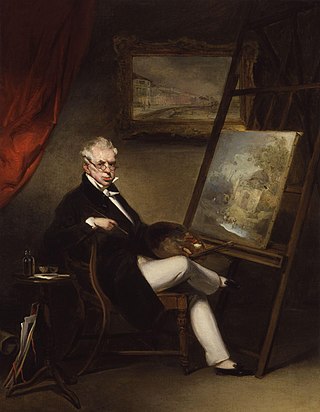
George Chinnery was an English painter who spent most of his life in Asia, especially India and southern China.

The Third of May 1808 in Madrid is a painting completed in 1814 by the Spanish painter Francisco Goya, now in the Museo del Prado, Madrid. In the work, Goya sought to commemorate Spanish resistance to Napoleon's armies during the occupation of 1808 in the Peninsular War. Along with its companion piece of the same size, The Second of May 1808, it was commissioned by the provisional government of Spain at Goya's own suggestion shortly after the ousting of the French occupation and the restoration of King Ferdinand VII.

The Meadows Museum, nicknamed "Prado on the Prairie", is a two-story, 66,000 sq. ft.art museum in Dallas, Texas on the campus of Southern Methodist University (SMU). Operating as a division of SMU's Meadows School of the Arts, the museum houses one of the largest and most comprehensive collections of Spanish art outside of Spain, with works dating from the 10th to the 21st centuries.

Thomas Hill was an American artist of the 19th century. He produced many fine paintings of the Californian landscape, in particular of the Yosemite Valley, as well as the White Mountains of New Hampshire.

Solomon Joseph Solomon was a British painter, a founding member of the New English Art Club and member of the Royal Academy.
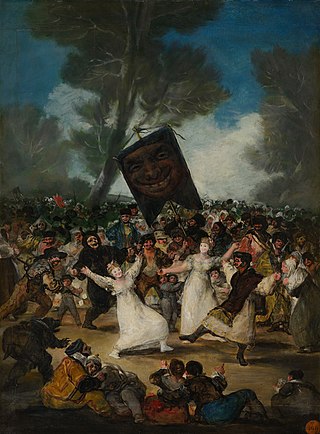
The Burial of the Sardine is an oil-on-panel painting by Spanish artist Francisco Goya, usually dated to the 1810s. It is held at the Real Academia de Bellas Artes de San Fernando, in Madrid.
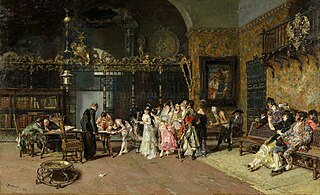
The Spanish Wedding or La Vicaría (1868–1870) is a masterwork by Marià Fortuny i Marsal, also known as Marià Fortuny or Mariano Fortuny. La Vicaría exemplifies genre painting of the 19th century. The use of jewel tones, contrasts between light and dark, and the virtuosity of the work attest to Fortuny's talent. It resides at Museu Nacional d'Art de Catalunya in Barcelona, Spain.
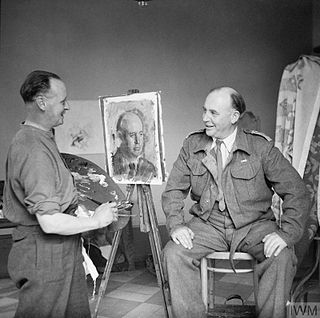
Henry Marvell Carr,, was a successful British landscape and portrait painter who served as a war artist during World War II.
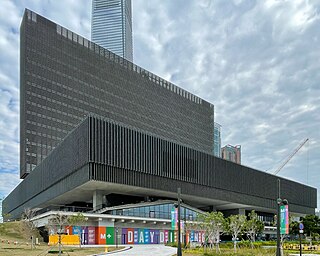
M+ is an art museum located in the West Kowloon Cultural District of Hong Kong. It exhibits twentieth and twenty-first century art encompassing visual art, design and architecture, and moving image. It opened on 12 November 2021.

Summer or The Threshing Floor is the largest cartoon painted by Francisco de Goya as a tapestry design for Spain's Royal Tapestry Factory. Painted from 1786 to 1787, it was part of his fifth series, dedicated to traditional themes and intended for the heir to the Spanish throne and his wife. The tapestries were to hang in the couple's dining room at the Pardo Palace.

Mademoiselle V. in the Costume of an Espada is an 1862 oil-on-canvas painting by French artist Édouard Manet. The painting is in the collection of the Metropolitan Museum of Art, having been acquired in 1929. Manet exhibited the painting at the 1863 Salon des Refusés alongside Jeune Homme en costume de majo and Le Déjeuner sur l'herbe. It is often cited as an example of Manet's work being influenced by Spanish art.

Truth, Time and History is an oil-on-canvas painting by the Spanish artist Francisco de Goya. The painting is also known by the titles Spain, Time, and History and Allegory of the Constitution of 1812. It has been assigned dates ranging from 1797 to 1812, though it is most commonly dated between 1804 and 1808. It is currently in the collection of the Nationalmuseum in Stockholm.






















